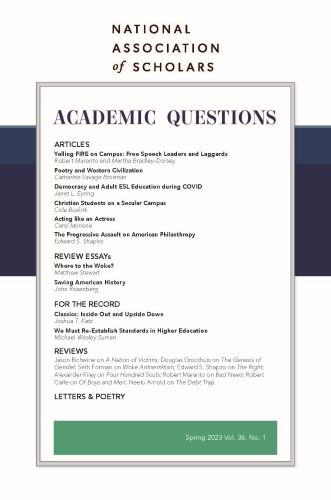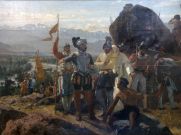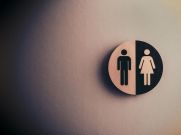Bad News: How Woke Media Is Undermining Democracy, Batya Ungar-Sargon, Encounter Books, 2021, pp. 301, $28.99 hardcover.
Robert Maranto is the 21st Century Chair in Leadership in the Department of Education Reform at the University of Arkansas; [email protected]. He is a cofounder of the Society for Open Inquiry in the Behavioral Sciences and last appeared in AQ in fall of 2022 with “What You Can Do for the Counterrevolution,” a review of Counter Wokecraft: A Field Manual for Combatting the Woke in the University and Beyond by Charles Pincourt, with James Lindsay.
Analyzing media bias is nothing new, serving as catnip not just to conservatives but to leftists and even some mainstream journalists. Nearly a half century ago former Washington Post Saigon bureau chief Peter Braestrup empirically demonstrated that reporters delivered fake news in portraying the 1968 Tet Offensive as a Communist military success rather than a meatgrinder which wrecked the National Liberation Front (Viet Cong) as a fighting force. Misreporting had huge implications, restricting the options available to American leaders.1
There is a small, but important political science literature on media bias. In a series of works including Environmental Cancer: A Political Disease (1999) Stanley Rothman and S. Robert Lichter2 showed empirically that reporters treated charges by progressive activists as beyond question, while ignoring far less alarmist scientific findings. This was not mere fearmongering to win readers since reporters treated scary claims by conservative activists with proper journalistic skepticism, not reverence. Broader, more recent, and equally sophisticated research by political economist Tim Groseclose shows that the left tilt identified by Rothman and Lichter grew in the 2000s. Groseclose recommended more ideological diversity among reporters to check their normal human biases.3
While sound social science, these works pale before Batya Ungar-Sargon’s brilliant Bad News: How Woke Media is Undermining Democracy. A media insider who earned a Berkeley Ph.D. in the eighteenth-century novel before becoming deputy opinion editor at Newsweek, Ungar-Sargon has written a page turner offering original insights into how media history shapes today’s media politics. Bad News is the one book to read on how we got a woke reportorial class, with class being the key term. Essentially, Ungar-Sargon dissects elite media isolation and corresponding blue-collar alienation.
Unger-Sargon begins in the 1830s, when a publication’s annual subscription might cost a month’s wages. This made journalism upscale, anti-labor and often pro-slavery, even in the North. A free, largely literate working class offered a potential market. On finding that London newspapers were cheap enough for skilled laborers, ambitious printer Benjamin Day started the “penny press” with the New York Sun, hawked daily on the streets by the original newsboys. So named since the sun shines on all, the Sun catered to working-class tastes, with dramatic headlines like “Arrest of an Arch Villain! Horrid Transaction.” The Sun started the first daily crime reporting after a formerly unemployed printer volunteered to attend court at 4:00 every morning to take down police reports. The Sun’s low price and high circulation attracted both workers seeking positions and employers offering them, though its sympathies lay with the underdogs.
Ambitious immigrant Joseph Pulitzer refined this strategy. Both Pulitzer’s personal sympathies and circulation incentives lay in confronting the rich and comforting the poor. At the St. Louis Post-Dispatch and later the New York World, Pulitzer uncovered police brutality, tainted meat, and titans who paid no taxes. He catered to the poor but never condescended to them: “his reporters covered the crime committed by the lower classes with as much luster as they did the crimes perpetrated against them by the rich.” (37) By 1890 the once homeless Pulitzer sold a million copies daily.
Upscale journalism began a comeback in the 1850s when Henry Raymond started the New York Daily Times, soon dropping the “Daily” to become the New York Times. Born to hardscrabble farmers, Raymond earned a college degree, parlaying connections into success in politics and journalism. Seeking bourgeois respectability, Raymond found a way to make it pay by branding the Times as the paper of rich, mushrooming ad revenues. Class insecurity was even more pronounced for Adolph Ochs, who bought the Times in 1896 and whose descendants (cum Sulzberger) retain ownership today. A Jew from Cincinnati at a time of rising antisemitism among eastern elites, Ochs craved gentile approval, as did his descendants. This reached absurd lengths, as when the paper deliberately refused to mention that Hitler’s victims were Jewish! Ungar-Sargon sees echoes of this antisemitism in the paper’s historic and contemporary coverage of Israel. (215-21)
After Watergate, journalists became more elite, and more liberal. As late as 1984 a quarter of reporters voted for Reagan, but by 2018 just 4 percent had conservative political views. In part this reflected the Internet’s cratering of journalistic jobs in flyover country. By 2017 new journalists were increasingly trained by a handful of elite universities, with most residing in the most pro-Clinton counties. New entrants to the field identified with the rich rather than the workers—the liberal rich—91 percent of New York Times readers identified as Democrats. When the Times’s fashion magazine “showcased Angela Davis on the front cover and an ad for a Cartier watch on the back cover,” Ungar-Sargon quips, “these are not in tension with each other, but rather two sides of the same coin.” (8) When the Los Angeles Times decided to compete with the New York Times for prestige, “top editors knew what they had to do: switch from being conservative to being liberal.” (77) Ideological and class homogeneity eroded journalistic objectivity. The Internet and social media further pushed journalists to write stories appealing to the base to develop their brand, a dynamic culminating in the 1619 Project. This class-based redlining opened a lane for conservative media to become a twenty-first century penny press.
Journalists and Donald Trump fed off each other. While making a big show of its opposition, CNN privately encouraged Trump to run and even offered tips about how to win a CNN-sponsored primary debate. Media outlets overcovered Trump, even goading him to attack them by name in order to attract readers. In 2017 “Trump” was the fourth most used word in the New York Times. (124) As detailed by Matt Taibbi,4 a media critic whom Ungar-Sargon relies on, reporters kept revisiting discredited Trump-Russia collusion stories, in part, because readers wanted them to. Such journalistic misconduct reflected the erosion of norms of objectivity, and the merging of the business and journalistic sides of publications.
This enabled the elite moral panic over race. Just as 1980s parents were convinced that local teens playing Dungeons & Dragons were Satan worshippers, today’s affluent parents have been persuaded by “experts” like Robin DiAngelo that everything is racist. (178) Younger reporters arriving from elite colleges increasingly bullied their senior colleagues with ever expanding definitions of racism. The paradigmatic example came when the New York Times published a commentary by U.S. Senator Tom Cotton arguing for using troops to restore order during the 2020 Black Lives Matter riots, views endorsed by most minorities. Caving to a mob of younger, woker reporters, Times leadership initially scapegoated a single junior editor, but eventually fired or reassigned four others, lying about nearly every aspect of the process. Such is the state of elite journalistic ethics.
Alas, racial bullying was what many upscale national readers wanted. After 2014, elite media mentions of white supremacy increased exponentially, proving reliable clickbait. (144-45) As Martha Bradley-Dorsey and I reported in these pages, in the weeks after a Minneapolis police officer killed George Floyd, the New York Times published hundreds of Black Lives Matter related articles, but literally never reported that police very rarely kill blacks, that most such killings are justified, and that de-policing increased “black on black” homicide.5 Ungar-Sargon details this media malpractice, as well as the failure to cover growing minority support and falling white support for Trump (235-37). Times reporters and readers did not want to hear scholarly evidence disproving wokeness. As Ungar-Sargon writes (155-56), “as America has gotten less racist, the media has gotten more obsessed with racism, [and] it started in academia” as higher education replaced facts with postmodernism. On race, educated white liberals were incredibly patronizing toward minorities even while moving to their left politically. Ungar-Sargon observes that “the re-racialization of American life through a woke culture war was simply the next phase in the status revolution of journalists—and who they viewed as their readers.” (165) Interestingly, the black press (and black people) largely eschewed these trends. (195-200)
As Ungar-Sargon writes, the moral panic over race “doesn’t actually ask that much of [readers] beyond guilty feelings” since “if the root of inequality lies in something as immutable as your whiteness, rather than any economic or political decision you have control over, you can’t do anything about it but feel guilty.” (165-66) I must add that in practice rich liberals could do a lot about inequity, even as they define it. Harvard could stop apologizing for its supposed history of profiting off racism and instead donate a fraction of its $40 billion endowment to impoverished HBCUs. Elite colleges might end land acknowledgements and instead return the land. I doubt that will happen any time soon.
I have only two criticisms of Bad News. First, Ungar-Sargon should say more about values not involving race. She knows that working-class Americans prioritize “religion, local community, patriotism, autonomy, and personal responsibility—ideals alien to today’s Left” (242) but does too little to develop that theme. Second, Ungar-Sargon waits until the final four pages to offer what turn out to be individual solutions for collective problems. She wants individual elites to curb social media outrage, to approach the workers with humility, to enter nonpolitical life spaces like organized religion, and to encourage more intellectual diversity and debate.
This is fine as far as it goes, but really, how many reporters will choose to act like a mensch if doing so might get them fired? Most will instead avoid risk, joining cancellation mobs rather than defending victims.
I propose two solutions to this collective dilemma. Ungar-Sargon sees academia as the source of many of our media troubles. This offers an opportunity since even private colleges receive public funds. The Foundation for Individual Rights and Expression (FIRE) now rates the free speech climates of 209 institutions, so we know who is naughty and nice. Elected leaders should defund colleges which undermine the First Amendment, just as we would those abrogating the Fourteenth Amendment. Demote their leaders and hold extensive state legislative and congressional hearings explaining why.6 After all, why should tax dollars support college administrators who want to erase half of all taxpayers?
Second, we need to start teaching K-12 students about America’s history of freedom and the vital role of a free and independent press in securing it. This should be compared to communist systems that thwarted the free press, centralized control of information, and thrived on tyranny. How can students defend liberty against Marxism if they have never heard of either? One way to inoculate future citizens against horrid ideas is for states to adopt the American Birthright K-12 Social Studies Standards (American Birthright: The Civics Alliance's Model K-12 Social Studies Standards—Сivics Alliance), which the National Association of Scholars developed with allies.
Yet these are minor criticisms. In writing Bad News, journalist Ungar-Sargon has done a great national service by explaining how woke journalism happened—now it is up to the rest of us to rebuild a credible free press.
1Big Story: How the American Press and Television Reported and Interpreted the Crisis of Tet 1968 in Vietnam and Washington (Boulder, Colorado: Westview Press, 1977).
2(New Haven: Yale University Press, 1999). Stanley Rothman made enormous contributions to social science, particularly through quantitative research on reporters and other elites, as detailed in a Festschrift published in Academic Questions volume 28, no. 4 (2015).
3Left Turn: How Liberal Media Bias Distorts the American Mind (New York City: St. Martin's Press, 2012).
4 Hate Inc., Why Today’s Media Makes us Despise One Another (New York City: OR Books, 2021).
5 “Can Academia and the Media Handle the Truth? Does Activist Academia and Elite Journalism Promote Black Lives Matter, But Cost Black Lives?” Academic Questions 33, no. 4: 592-98. DOI 10.1007/s12129-020-09919-1.
6 Robert Maranto, Catherine Salmon, and Lee Jussim, “Cut Their Pay and Make Then Teach,” RealClearEducation, June 9, 2022 at https://www.realcleareducation.com/articles/2022/06/09/cut_their_pay_and_make_them_teach_110737.html.
Photo by mitrija on Adobe Stock













